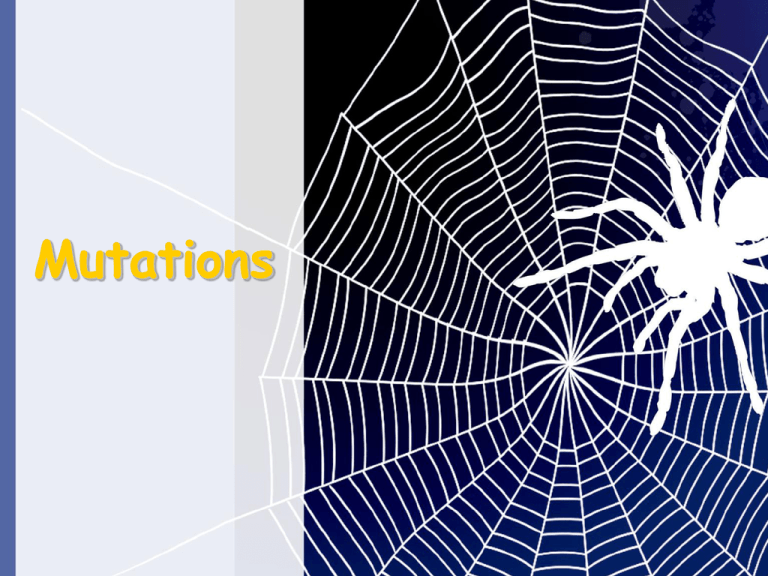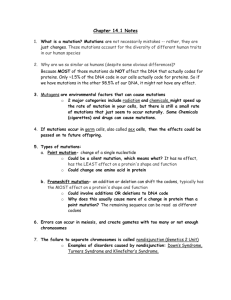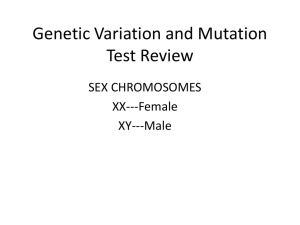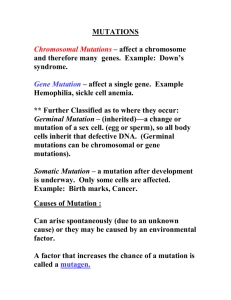Mutations
advertisement

Mutations What Are Mutations? • Changes in the nucleotide sequence of DNA • May occur in somatic cells (aren’t passed to offspring, only to descendant cells) • May occur in germ-line cells (eggs & sperm) and be passed to offspring Are Mutations Helpful or Harmful? • Mutations happen regularly • Almost all mutations are neutral • Chemicals & UV radiation cause mutations • Many mutations are repaired by enzymes Types of Mutations Point Mutations • Change in the nucleotide sequence of a one or a few base pairs • May be due to copying errors, chemicals, viruses, etc. Types of Point Mutations • Include: – Substitutions – Frame-shift Mutations (Insertion, Deletion) Substitution • One or more nucleotides are changed to a different base. • AAC GCC AGC • AAG GCC AGC • Can cause an amino acid to be changed…or not! Frame-shift Mutation • Inserting or deleting one or more nucleotides • Changes the “reading frame” like changing a sentence • Proteins built incorrectly Frameshift Mutation • Original: – The fat cat ate the wee rat. • Frame Shift (“a” added): – The fat caa tet hew eer at. Amino Acid Sequence Changed Gene Mutation Animation How Would the Phenotype Change? Missense Substitution • Sickle Cell disease is the result of one nucleotide substitution • Occurs in the hemoglobin gene Nonsense Substitution • Thallasemia is the result of a stop codon substitution that shortens the gene • Occurs in the hemoglobin gene Silent Mutation • The Genetic Code is repetitive – there are 64 codons that code for 20 amino acids. • A silent mutation makes no change in amino acid sequence: Deletion • Cystic fibrosis (mucus in the lungs) is the result of one nucleotide deletion • Causes a frameshift! Insertion • Huntington’s Disease (nerve cell deterioration) is the result of many nucleotide insertions (CAG repeats) Chromosome Mutations • May Involve: – Changing the structure of a chromosome – The loss or gain of part of a chromosome Chromosome Mutations • Five types exist: – Deletion/Insertion – Duplication – Inversion – Translocation – Nondisjunction Deletion • Due to breakage • A piece of a chromosome is lost Insertion An additional piece of chromosome is added Deletion • Cri-du-Chat is caused by a deletion in one of the chromosomes. • Causes an abnormal larynx Duplication • Occurs when a gene sequence is repeated Inversion • Chromosome segment breaks off • Segment flips around backwards • Segment reattaches Translocation • Involves two chromosomes that aren’t homologous • Part of one chromosome is transferred to another chromosomes Translocation Nondisjunction • Failure of chromosomes to separate during meiosis • Causes gamete to have too many or too few chromosomes • Disorders: – Down Syndrome – three 21st chromosomes – Turner Syndrome – single X chromosome – Klinefelter’s Syndrome – XXY chromosomes Chromosome Mutation Animation Normal Male 30 Normal Female 31 Male, Trisomy 21 (Down’s) 2n = 47 32 Female Down’s Syndrome 2n = 47 33 Turner’s Syndrome 2n = 45 34 Turner’s Syndrome 35 Klinefelter’s Syndrome 36 Klinefelter’s Syndrome 37








